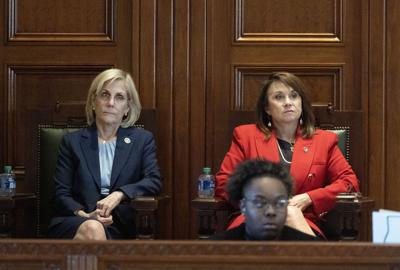WASHINGTON — Reading the tea leaves of complex legal briefs has some wondering if the state of Louisiana may be trying to abandon the second majority-Black congressional district approved by the Legislature in January, then rejected by two federal judges April 30, in favor of the old map that pretty much guarantees the election of five White Republican and one Black Democratic congresspersons.
“The state has been a little fuzzy,” said Michael Li, of New York’s Brennan Center and one of the nation’s foremost experts on redistricting.
Attorney General Liz Murrill asked the U.S. Supreme Court on Friday to suspend, or stay, the judges’ order — which would mean using the Legislature’s map with two Black opportunity districts. Murrill said she wants to get the two Black majority district map approved.
But without a stay, Murrill argued that Secretary of State Nancy Landry won’t have the time necessary to enter the data from the Legislature’s configuration, called SB8 after the bill creating the new map, or any subsequent map, into the office’s database by May 15 in order to stage the Nov. 4 congressional election properly.
Failing a stay, the state argued, Landry would have no option but to use the 2022 map, which is already in the office’s system. That map was used in 2022 to elect the state’s present congressional delegation of five White Republicans and one Black Democratic member.
“I don’t know if that’s legally possible,” said state Rep. Kyle Green, D-New Orleans, noting that the Legislature specifically revoked the law creating the old map, leaving SB8 the only configuration for congressional elections.
In tossing the new map, two of the panelists, U.S. District Judges David C. Joseph and Robert R. Summerhays, both President Donald Trump nominees, found legislators gave race too much prominence in creating a second Black majority district. Disagreeing, 5th U.S. Circuit Judge Carl Stewart, who was nominated by President Bill Clinton and is the third panelist, found legislators put just as much weight on political concerns.
The rejected map, which became law Jan. 22, protected House Speaker Mike Johnson, R-Benton, and House Majority Leader Steve Scalise, R-Jefferson, as well as Rep. Julia Letlow, R-Start, a member of the House Appropriations Committee.
The Legislature’s new majority-Black district linked Black populations diagonally across the state from Baton Rouge to Shreveport. And it left Baton Rouge-based Rep. Garret Graves, a White Republican who has made enemies of some prominent members of his own party, in a majority-Black district comprised mostly of voters he has never represented.
The rejection of that map left Louisiana without any congressional districts in force. Unless stopped by the U.S. Supreme Court, the panel will impose an interim map on June 4, though the Legislature could act before then.
The possibility of going back to the 2022 map, foreshadowed in the state’s filing, sufficiently worried one tranche of predominantly Black voters who had intervened in the case to seek Thursday the intervention of Chief U.S. District Judge Shelly Dick, of Baton Rouge.
Dick in 2022 opined in a related case that Blacks made up a third of the state’s population and lived close enough together to one another that they should have a second minority-majority district, as required under the Voting Rights Act. She noted that Louisiana has never elected a Black congressional candidate in a White majority district.
Another tranche of predominantly Black voters asked the panel Thursday if it planned to follow Dick’s opinion.
“The state has that evidence here in spades,” Murrill wrote in support of persuading the Supreme Court to get involved. She noted that a 5th Circuit panel found that Dick’s rulings “did not clearly err in its necessary fact-findings nor commit legal error in its conclusions.”
In asking for a Supreme Court stay, Murrill wrote: “The urgent reality is that — whatever the Court’s decision on the merits — Louisiana desperately needs a stay of the (panel’s) injunction and remedial proceedings that leave Louisiana with no congressional map (and no hope of one for some time) five days away from the first critical deadline.”
The high court ordered responses to the state’s appeal by May 13.
Of course, the nation’s top court can do whatever it wants, but if the justices follow what they’ve done in the past, a stay likely would mean the November congressional elections would use the Legislature’s 2024 map, which could force Graves into running in a second Black majority district. In June 2022, that’s what the justices did when confronted with appeals of Dick’s findings — the 2022 map Dick had rejected as the only map available.
“The state keeps doubling down on this May 15 deadline,” said Victoria Wenger, who is one of the NAACP Legal Defense and Education Fund representing a tranche of mostly Black voters called the Robinson intervenors. “We’re left in this limbo land. It’s a head scratcher that HB1 [the 2022 map] is back in the conversation.”


